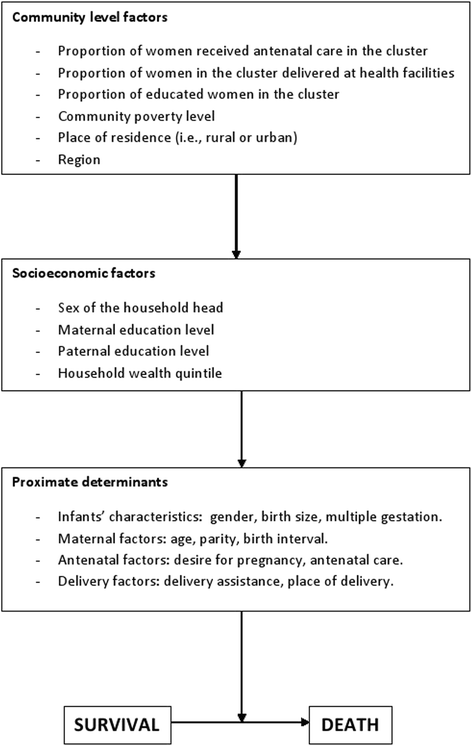Determinants of early neonatal mortality in Afghanistan: an analysis of the Demographic and Health Survey 2015
- PMID: 29743085
- PMCID: PMC5944060
- DOI: 10.1186/s12992-018-0363-8
Determinants of early neonatal mortality in Afghanistan: an analysis of the Demographic and Health Survey 2015
Abstract
Background: Neonatal mortality is declining slowly compared to under-five mortality in many developing countries including Afghanistan. About three-fourths of these deaths occur in the early neonatal period (i.e., the first week of life). Although a number of studies investigated determinants of early neonatal mortality in other countries, there is a lack of evidence regarding this in Afghanistan. This study investigated determinants of early neonatal mortality in Afghanistan.
Methods: Data from the Afghanistan Demographic and Health Survey 2015 (AfDHS 2015) were analyzed. After reporting the weighted frequency distributions of selected factors, a multilevel logistic regression model revealed adjusted associations of factors with early neonatal mortality.
Results: A total of 19,801 weighted live-births were included in our analysis; 266 (1.4%) of the newborns died in this period. Multivariable analysis found that multiple gestations (adjusted odds ratio (AOR): 9.3; 95% confidence interval (CI): 5.7-15.0), larger (AOR: 2.9; 95% CI: 2.2-3.8) and smaller (AOR: 1.8; 95% CI: 1.2-2.6) than average birth size, maternal age ≤ 18 years (AOR: 1.8; 95% CI: 1.1-3.2) and ≥ 35 years (AOR: 1.7; 95% CI: 1.3-2.3), and birth interval of < 2 years (AOR: 2.6; 95% CI: 1.4-4.9) had higher odds of early neonatal mortality. On the other hand, antenatal care by a skilled provider (AOR: 0.7; 95% CI: 0.5-0.9), facility delivery (AOR: 0.7; 955 CI: 0.5-0.9), paternal higher education level (AOR: 0.7; 95% CI: 0.5-1.0), living in north-western (AOR: 0.3; 95% CI: 0.1-0.6), central-western regions (AOR: 0.5; 95% CI: 0.3-0.9) and in a community with higher maternal education level (AOR: 0.4; 95% CI: 0.2-0.9) had negative association.
Conclusions: Several individual, maternal and community level factors influence early neonatal deaths in Afghanistan; significance of the elements of multiple levels indicates that neonatal survival programs should follow a multifaceted approach to incorporate these associated factors. Programs should focus on birth interval prolongation with the promotion of family planning services, utilization of antenatal care and institutional delivery services along with management of preterm and sick infants to prevent this large number of deaths in this period.
Keywords: Afghanistan; Demographic and health survey; Determinants; Early neonatal mortality.
Conflict of interest statement
Ethics approval and consent to participate
Ethical approval for this study was not required as the data were available for use upon approval. We obtained permission to use the data from the ICF International, Rockville, Maryland, USA in May 2017.
Competing interests
The authors declare that they have no competing interests.
Publisher’s Note
Springer Nature remains neutral with regard to jurisdictional claims in published maps and institutional affiliations.
Figures
Similar articles
-
Early neonatal mortality and determinants in sub-Saharan Africa: Findings from recent demographic and health survey data.PLoS One. 2024 Jun 7;19(6):e0304065. doi: 10.1371/journal.pone.0304065. eCollection 2024. PLoS One. 2024. PMID: 38848390 Free PMC article.
-
Effect of maternal height on caesarean section and neonatal mortality rates in sub-Saharan Africa: An analysis of 34 national datasets.PLoS One. 2018 Feb 6;13(2):e0192167. doi: 10.1371/journal.pone.0192167. eCollection 2018. PLoS One. 2018. PMID: 29408912 Free PMC article.
-
Factors associated with low birth weight in Afghanistan: a cross-sectional analysis of the demographic and health survey 2015.BMJ Open. 2019 May 14;9(5):e025715. doi: 10.1136/bmjopen-2018-025715. BMJ Open. 2019. PMID: 31092648 Free PMC article.
-
Rates and determinants of neonatal mortality in two rural sub-districts of Sylhet, Bangladesh.PLoS One. 2018 Nov 21;13(11):e0206795. doi: 10.1371/journal.pone.0206795. eCollection 2018. PLoS One. 2018. PMID: 30462674 Free PMC article.
-
Trends in neonatal mortality in Nigeria and effects of bio-demographic and maternal characteristics.BMC Pediatr. 2015 Apr 9;15:36. doi: 10.1186/s12887-015-0349-0. BMC Pediatr. 2015. PMID: 25886566 Free PMC article. Review.
Cited by
-
Determinants of Health Facility Utilization at Birth in South Sudan.Int J Environ Res Public Health. 2019 Jul 9;16(13):2445. doi: 10.3390/ijerph16132445. Int J Environ Res Public Health. 2019. PMID: 31324060 Free PMC article.
-
Determining factors of neonatal mortality in Ethiopia: An investigation from the 2019 Ethiopia Mini Demographic and Health Survey.PLoS One. 2022 Dec 30;17(12):e0267999. doi: 10.1371/journal.pone.0267999. eCollection 2022. PLoS One. 2022. PMID: 36584102 Free PMC article.
-
Disparities, distribution, and determinants in appropriate timely initiation, number, and quality of antenatal care in Bangladesh: Evidence from Demographic and Health Survey 2017-18.PLOS Glob Public Health. 2023 Aug 23;3(8):e0002325. doi: 10.1371/journal.pgph.0002325. eCollection 2023. PLOS Glob Public Health. 2023. PMID: 37610995 Free PMC article.
-
Early neonatal mortality and determinants in sub-Saharan Africa: Findings from recent demographic and health survey data.PLoS One. 2024 Jun 7;19(6):e0304065. doi: 10.1371/journal.pone.0304065. eCollection 2024. PLoS One. 2024. PMID: 38848390 Free PMC article.
-
Time, cause of early neonatal death, and its predictors among neonates admitted to neonatal intensive care units at Bahir Dar City public hospitals, northwest Ethiopia: a prospective follow-up study.Front Pediatr. 2024 Jun 11;12:1335858. doi: 10.3389/fped.2024.1335858. eCollection 2024. Front Pediatr. 2024. PMID: 38919840 Free PMC article.
References
-
- You D, Hug L, Ejdemyr S, Idele P, Hogan D, Mathers C, Gerland P, New JR, Alkema L, United Nations Inter-agency Group for Child Mortality Estimation (UN IGME) Global, regional, and national levels and trends in under-5 mortality between 1990 and 2015, with scenario-based projections to 2030: a systematic analysis by the UN inter-agency Group for Child Mortality Estimation. Lancet. 2015;386(10010):2275–2286. doi: 10.1016/S0140-6736(15)00120-8. - DOI - PubMed
-
- UN Inter–agency Group for Child Mortality . Child Mortality Estimates September 2015. 2015.
-
- United Nations, Sustainable Development Goals. http://www.un.org/sustainabledevelopment/health/. Accessed 6 May 2017.
-
- Central SO, Ministry of PH, ICF . Afghanistan Demographic and Health Survey 2015. 2017.
-
- Central Intelligence Agency - The World Factbook. https://www.cia.gov/library/publications/the-world-factbook/geos/af.html. Accessed 6 May 2017.
MeSH terms
LinkOut - more resources
Full Text Sources
Other Literature Sources


